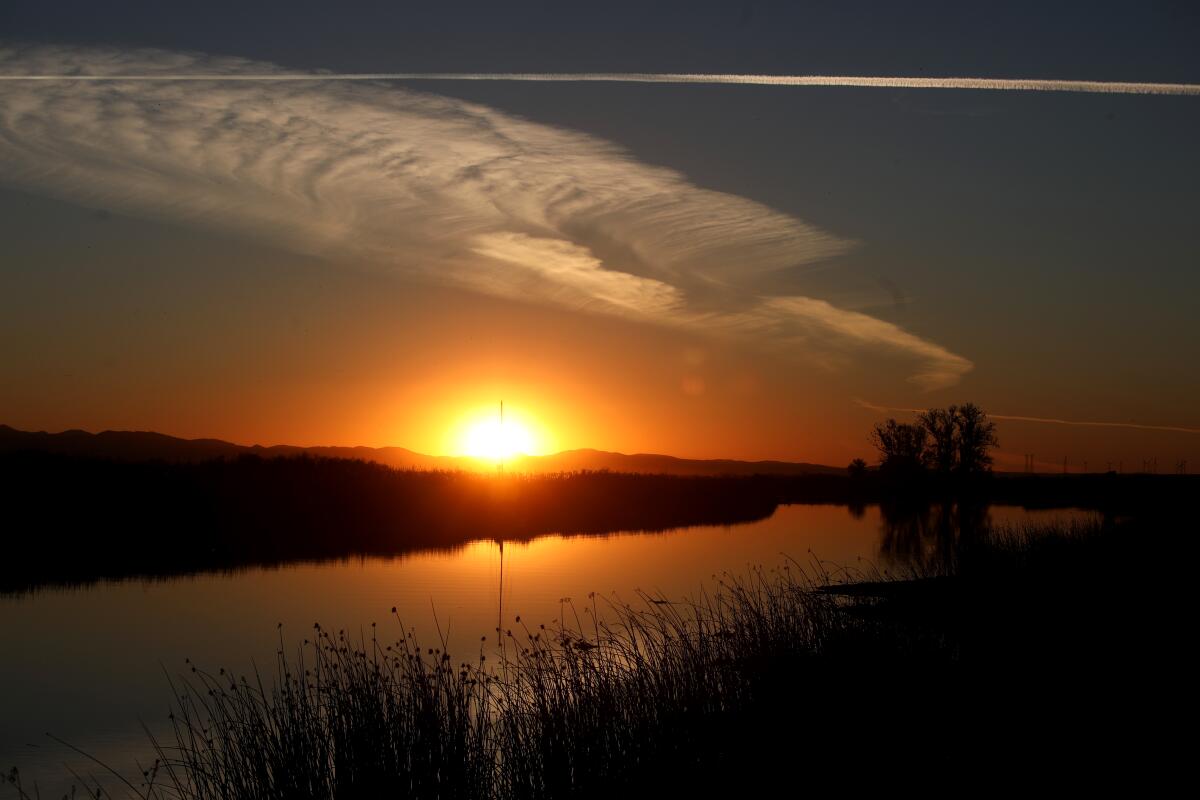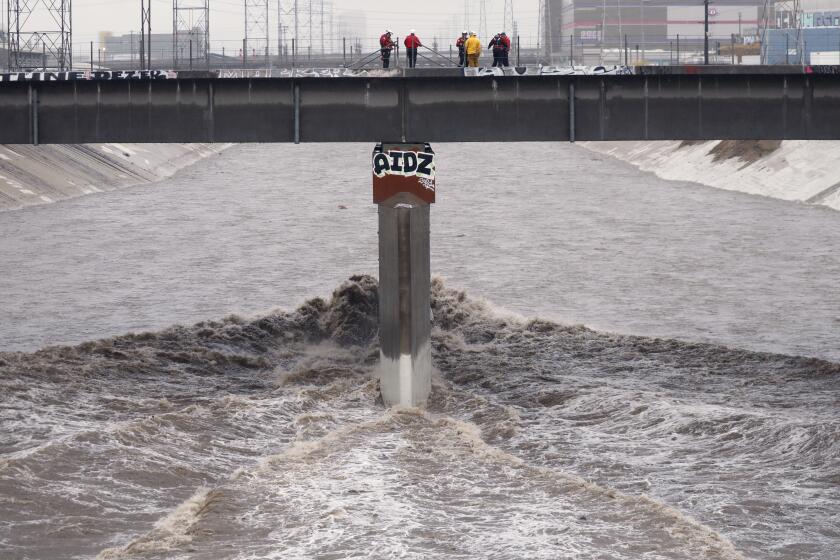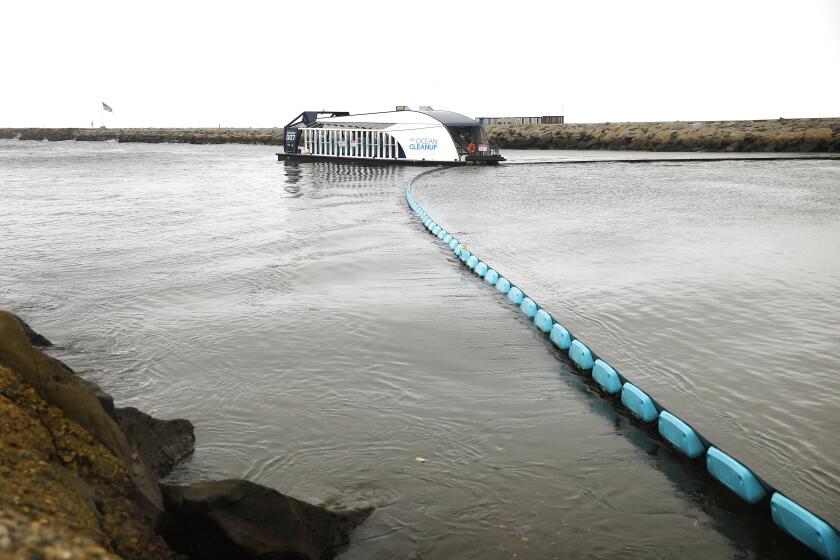Uncaptured water isn’t wasted. But more could be stored for a non-rainy day

- Share via
SACRAMENTO — A gazillion gallons of stormwater have been rampaging down rivers into the sea. But that uncaptured bounty hasn’t been “wasted.”
“Wasted water” being dumped in the ocean is an old cliché that resurfaces whenever there’s a big storm in this weather-eccentric state — or during the inevitable dry periods when crops are thirsty and homeowners are told to shut off their lawn sprinklers.
But “wasted water” is a myth.
Uncaptured runoff flowing to the sea flushes pollutants out of rivers and bays, helping to cleanse water for local domestic use. It also saves many kinds of fish, including salmon, not only for recreationists but for the coastal fishing industry. And it deposits sand on beaches.
In the vital Sacramento-San Joaquin River Delta, runoff pushes back saltwater from San Francisco Bay, making the relatively small amount of water that is captured potentially drinkable.
That’s the view of water scholars I’ve talked to recently. And it makes sense, particularly concerning flows through real rivers. That doesn’t necessarily include concrete-lined flood channels, such as the so-called Los Angeles River.
“Every drop of water flowing out of the Central Valley into San Francisco Bay creates benefits,” asserts Jeffrey Mount, a water expert at the Public Policy Institute of California. He’s a former UC Davis science professor and founding director of the university’s Center for Watershed Sciences.
But he continues: “I want to be perfectly clear. That doesn’t mean we couldn’t harvest more.”
He also adds this caveat: “There are some places where water is just wasted to sea. I’m thinking where I grew up — in Santa Monica. Street runoff there has no demonstrable value.” That is, unless it’s captured and recycled or stored underground, he notes.
In 2018, L.A. County voters approved Measure W, a massive tax aimed at protecting beaches and improving water supply through storm water capture. Yet only $95.5 million has been disbursed for projects out of $556 million collected.
But even uncaptured water headed to sea through the L.A. River is beneficial, he contends.
“It cleans out the channel. The L.A. River is watered by urban slobber, an unpleasant mix of oils and other nasty stuff.”
Unfortunately, it winds up “in places where surfers are,” he says. “The ocean is full of viruses by the time they paddle out.”
Mount’s PPIC colleague, Greg Gartrell, says the L.A. and lower San Gabriel rivers were turned into flood control channels “to get the water off the land as fast as possible so they could build houses in floodplains.”
The channels “almost immediately filled up with sediment,” he continues.
“They put in sediment basins to catch the sediment so it wouldn’t go into the channels. Then we started losing sand on the beaches.”
The sand flows down from mountains as well as ocean cliffs.
“If we didn’t build in flood plains,” Gartrell adds, “we wouldn’t have to do many of these projects.”
The issue of whether to capture and store more runoff or allow it to flow freely into the ocean is more controversial in Northern California, where there are bona fide rivers.
The atmospheric river storm hitting California this week presents a test for an experimental waste-capturing system that’s intended to keep plastic bottles, diapers and other trash from flowing into the Pacific.
The Sacramento-San Joaquin delta, fed by several rivers originating in the snow-covered mountains and flowing through the agriculture-rich Central Valley, is the source of drinking water for 27 million Californians and irrigation for 3 million acres of crops. The uncaptured water flows into San Francisco Bay and out through the Golden Gate into the Pacific.
“Most of this water is not just uncaptured — it’s uncapturable,” says Gartrell, a delta expert, independent consulting engineer and former assistant general manager of the Contra Costa Water District.
“And it’s not actually wasted. It’s freshening San Francisco Bay.”
It’s uncapturable because of pumping capacity and aqueduct sizes, and often in wet years because reservoirs are practically full — particularly San Luis Reservoir in Merced County, the big holding pond for both the federal and state water projects. Last week, it was only half full, but is expected to fill by spring.
The future of storage is underground in aquifers, now dangerously depleted by over-pumping.
“We have a 150-million-acre-foot capacity underground — more storage than we’ll ever be able to use,” says Wade Crowfoot, secretary of the state Natural Resources Agency.
But Mount says, “We’re currently not set up for pumping underground” in large quantities. “We haven’t gotten our act together.”
State and federal delta pumps now are operating at near capacity, sending nearly 14,000 cubic feet per second through aqueducts into the San Joaquin Valley and Southern California. But that’s tiny compared to delta outflows, which last week were roughly 150,000 CFS. None of it wasted.
The wasted water issue is more relevant when runoff is normal or very low.
I called Mount after reading a UC Davis blog post he co-wrote six years ago, titled “Water wasted to the Sea?”
“The seaward flow of freshwater is essential to [delta] farmers, fishers, conservations, seashore lovers and government agencies that manage drinking water supplies, restore wetlands, protect coastlines and clean up sewage and storm pollution,” he concluded then.
“Wasted water to some is essential water to others.”
“I feel even stronger about it today,” Mount told me. “It’s a mistake to refer to any water that goes to the ocean as wasted.”
“I’m not saying all the water should go to the ocean. We could do a better job of storing some of it without impacting benefits.”
So, uncaptured water isn’t wasted. But when large amounts are suddenly gifted by nature, more could be stored for a non-rainy day.
More to Read
Sign up for Essential California
The most important California stories and recommendations in your inbox every morning.
You may occasionally receive promotional content from the Los Angeles Times.












